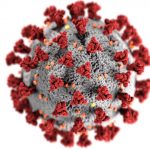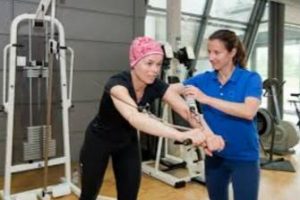January 9th, 2021 by Dr. Val Jones in Uncategorized
4 Comments »
 I used to joke that for all the hardships of being a physician, at least we had job security. Little did I know that a viral illness would put some physicians “on the bread line.”
I used to joke that for all the hardships of being a physician, at least we had job security. Little did I know that a viral illness would put some physicians “on the bread line.”
The COVID-19 pandemic has negatively impacted the physician workforce in both anticipated and unanticpated ways. While stay-at-home orders decrease temporary demand for cosmetic and elective surgical procedures by dermatologists and orthopedic surgeons, inpatient rehabilitation facilities are also feeling the squeeze, though the number of patients who need their services are growing exponentially (due to post-COVID syndromes).
In states of emergency, hospitals at (or over) capacity have the right to commandeer beds from other units within their system. So for example, if there is a unit devoted to the rehabilitation of stroke or car accident victims, the hospital might re-allocate those beds to COVID-19 patients. There is also financial incentive to do so because Medicare pays 20% higher rates to hospitals for each COVID patient that requires admission.
So what happens when the rehab unit turns into a COVID unit? A few things. First, the patients who need inpatient rehabilitation with close physician monitoring are turfed to nursing homes. Fragile stroke patients, those with high risk for neurological or cardiac decompensation, and inpatients with complex medical problems (such as internal bleeding, kidney failure, or infectious diseases) are sent to a lower level of care without suficient oversight by physicians. These patients often crash, get readmitted to the hospital, or in the worst case, decline too quickly to be saved.
Second, the physicians who take care of rehab patients (rehabilitation physicians, also known as physiatrists) hand over care of the COVID patients (in the former rehab unit) to hospitalists, reducing their own workloads substantially while the hospitalists are overwhelmed and at risk for burn out.
Third, hospitals are struggling to cut costs due to the suspension of their lucrative elective surgical pipelines during COVID surges – and put a moratorium on hiring additional physicians who would normally be assisting with growth and expansion efforts in neuromuscular, brain and spinal cord injury rehabilitation.
Finally, in some cases rehab units are experiencing low censuses not because their beds were commandeered for COVID patients, but because elective surgeries have diminished and patients are afraid of coming to the hospital. Many of those with symptoms of heart attacks, strokes, brain injuries, etc. are staying home and “gutting it out” while reversible or treatable injuries and disabilities become permanent. The devastating toll will be difficult to quantify until normal medical surveillance and care resumes.
Meanwhile, physiatrists with outpatient practices and pain management clinics are experiencing a dramatic drop in patient throughput, with telemedicine visits largely inaccessible to the poor and disabled populations they serve. Those outpatient physicians seek to augment their income with part-time inpatient work, and unprecidented numbers are seeking employment through locum tenens agencies. Unfortunately, agencies have scant inpatient jobs to offer for the reasons I discussed above, and competition is fierce among agencies and physicians alike. It’s often the case that 7 or more agencies will contact a physician within hours of a new job posting, and that job will be filled before the physician can respond – and at an hourly rate 20-30% lower than pre-COVID days (based on my personal experience).
These are some of the unexpected underemployment consequences of the COVID pandemic for one sub-specialty group: physiatry. I imagine the forces at play may be similar for my peers in oncology, neurology, or preventive medicine, for example.
One thing is for sure: emergency medicine physicians, internists, and critical care specialists are facing a tsunami of patients while others of us are sitting on the bench, wanting to help but not trained to do so, “sheltering in place” as the non-COVID march of disease and disability continues apace.
April 5th, 2017 by Dr. Val Jones in Health Tips, Opinion
1 Comment »
This blog post first appeared at: Curious Dr. George
 Rehabilitation medicine is one of the best-kept secrets in healthcare. Although the specialty is as old as America’s Civil War, few people are familiar with its history and purpose. Born out of compassion for wounded soldiers in desperate need of societal re-entry and meaningful employment, “physical reconstruction” programs were developed to provide everything from adaptive equipment to family training, labor alternatives and psychological support for veterans.
Rehabilitation medicine is one of the best-kept secrets in healthcare. Although the specialty is as old as America’s Civil War, few people are familiar with its history and purpose. Born out of compassion for wounded soldiers in desperate need of societal re-entry and meaningful employment, “physical reconstruction” programs were developed to provide everything from adaptive equipment to family training, labor alternatives and psychological support for veterans.
Physical medicine and rehabilitation (PM&R) then expanded to meet the needs of those injured in World Wars I & II, followed closely by children disabled by the polio epidemic. In time, people recognized that a broad swath of diseases and traumatic injuries required focused medical and physical therapy to achieve optimal long term function. Today, cancer patients frequently benefit from comprehensive rehabilitation as they recover from the effects of chemo (neuropathy, weakness, and cognitive impairments), radiation (scarring and range of motion limitations), surgery (flaps, plastics procedures, tumor resection, amputations), and brain injuries (edema, debulking, gamma knife and neurosurgery).
Rehabilitation is a phase of recovery occurring after any major life-changing medical or surgical event. Our bodies are designed to regenerate and repair, though optimizing this process takes skilled guidance. PM&R physicians (also known as physiatrists) are trained to use physical modalities (stretching, strengthening, heat, cold, etc.) to mechanically enhance healing. They prescribe medications to manage pain, spasticity, nerve injury, and cognitive impairments, while also leveraging the power of physical therapy to increase cardiopulmonary fitness, muscle strength and flexibility. PM&R physicians are also experts in neurologic injury, and can adapt exercises to coax spinal cord, brain and peripheral nerve injuries to construct new pathways for movement and repair.
Inpatient rehab’s prime directive is to get patients back home. To succeed at home, patients need to be able to function as independently as possible, using trained assistants for managing the activities that cannot be performed without help. Admission to a rehab hospital or unit offers the patient home practice opportunities – with simulated challenges that can include everything from terrain parks, test kitchens, medication management trials, driving simulators, balance tests, electric wheelchairs and even exoskeletons that allow paralyzed patients to walk again. It is like a robotic Disney World, with endless aquatic and equipment possibilities for restoring movement and independence.
When I discuss admission to inpatient rehab with my cancer patients, I ask them about their goals, motivation, and energy levels. Timing of rehab is important, because it must dovetail with treatment, so that the physical exertion strengthens, not saps, the patient. Often times when a person is newly diagnosed with cancer, they want “everything done” – intensive chemo/radiation/surgery as well as rehab/exercise. But staggering these interventions can be more effective.
In other cases when care is palliative, learning new skills and being fitted with battery or electric-powered equipment can mean the difference between living at home or in an assisted environment. Some successful cancer patients come to inpatient rehab to practice managing their activities of daily living with varied amounts of assistance, preparing for increased needs as time goes on so they can enjoy being at home for as long as possible.
For the physiatrist, cancer is a cause of impairments that can be overcome with creativity and practice, no matter the long-term prognosis. Adaptive equipment, physical exercise, and cognitive retraining may be applied intensively (3 hours a day in the inpatient setting), or at a slower outpatient pace, depending on individual need. Rehab physicians desire to support and sustain patient function at the highest level, and “add life to years.” As such, rehabilitation should be considered an integral part of successful cancer care and management.
February 3rd, 2017 by Dr. Val Jones in True Stories
1 Comment »
 Even though I don’t have an outpatient practice, I like to keep in touch with some of my patients after they’ve discharged from the rehab hospital. Jack is one of my very favorite success stories.
Even though I don’t have an outpatient practice, I like to keep in touch with some of my patients after they’ve discharged from the rehab hospital. Jack is one of my very favorite success stories.
I met Jack in a small regional hospital in rural western America. He had been admitted with sudden onset weakness, and during the intake process, accurately described his daily evening cocktail habit. Unfortunately, this led the clinicians down the wrong diagnostic pathway, presuming that alcohol withdrawal seizures were the cause of his weakness (due to a presumed “post-ictal” state).
A brain MRI was unremarkable, and so a fairly high loading dose of anti-seizure medications were started. Poor Jack happened to be very sensitive to meds, and reacted with frank psychosis. Days later he was still not in his right mind, and so a rehab consult was requested for “encephalopathy due to alcohol withdrawal.”
When I met Jack, it was clear on first glance that… [click here to read the rest of the story] or go to this link:
http://cliniciantoday.com/when-its-more-important-to-save-a-lifestyle-than-a-life/
June 16th, 2014 by Dr. Val Jones in Health Policy, Health Tips
No Comments »

Occupational Therapy Environment, Saint Luke's Hospital, WA
For most physicians who practice inpatient medicine, acute inpatient rehabilitation facilities are mysterious places with inscrutable admissions criteria. This is partly because physical medicine and rehabilitation (PM&R) has done the poorest job of public relations of any single medical specialty (Does anyone know what we do?), and also because rehab units have been in the cross hairs of federal funding cuts for decades. The restrictive CMS criteria for inpatient rehabilitation have resulted in contortionist attempts to practice our craft in an environment where clinical judgment has been sidelined by meticulous ICD-9 coding.
But I will not bore you with the reasons behind our seemingly capricious admissions criteria. Instead I will simply tell you what they are in the simplest way possible. After much consideration, I thought it would be easiest to start with the contraindications to acute rehab – I call these “red lights.” If your patients have any of these, then they will not qualify for transfer to the acute inpatient rehab unit. I followed the absolute contraindications with relative contraindications (you guessed it, “yellow lights”) – these patients require some clinical and administrative judgment. And finally, I’ve listed the official green lights – the diagnosis codes and medical necessity rules for the ideal inpatient rehab candidate.
I hope that these rules demystify the process – and can help discharge planners, rehab admissions coordinators, and acute care attending physicians alike help to get the right patients to acute inpatient rehab.
RED LIGHT (Patient does not meet criteria, admission is not currently indicated):
- Inability to Participate: Patient cannot tolerate 3 hours of therapy per day.
- Unwillingness to participate: The patient does not wish to participate in PT/OT/speech therapies and/or shows no evidence of motivation in previous attempts to perform therapy
- Poor rehabilitation potential: The patient’s functional status is currently no different than their usual baseline. (Confirmed by previous history, medical records, or reliable source.)
- Dementia: The patient has a chronic brain deficiency that is not expected to improve and makes carryover of training unlikely or impossible.
- Doesn’t need help from at least 2 different rehab disciplines: The patient must demonstrate likely benefit from working with at least 2 of these: PT, OT, Speech.
- Acute illness or condition: The patient has an acute illness/condition requiring medical intervention prior to transfer to an acute rehab facility – these include:
- septicemia (infection with fever and elevated white count)
- delirium (medication effect, dehydration, infectious, toxic-metabolic)
- unstable vital signs (severe hyper or hypotension, severe tachy or brady arrhythmia, hypoxia despite oxygen supplementation)
- acute psychotic episode (including active hallucinations or delusions)
- uncontrolled pain (the patient’s pain is not sufficiently controlled to allow participation in therapy)
- severe anemia
- extreme fatigue or lethargy due to medical condition
- Procedure or workup pending: The patient is in the middle of a work up for DVT, cardiac disorder, stroke, infection, anemia, chest pain, bleeding, etc. or is about to undergo a procedure (surgery, imaging study, interventional or lab test) that could alter the immediate course of his/her medical/surgical management.
YELLOW LIGHT (The patient may not be a good rehab candidate, clinical/administrative judgment required regarding admission):
- Possible poor rehabilitation potential: The patient’s prior level of function (PLOF) is likely low or similar to current level, however there is no clear documentation of the patient’s PLOF. It is unclear if aggressive rehabilitation will substantially improve the patient’s functional independence.
- Unclear benefit of ARU versus SNF: The patient is unlikely to avoid future placement at a skilled nursing facility. Would it be in the patient’s best interest to transfer there directly?
- Mild dementia or chronic cognitive impairment: The patient has carryover challenges but is able to participate and follow directions. There may be family members who could benefit from PT/OT/Speech training so they can take the patient home and be his/her caregiver(s).
- Unclear safe discharge plan: The patient lives alone or has no family support or has no financial means to improve their living conditions or their home is unfit for living/safe discharge or patient refusing SNF but qualifies otherwise.
- Insurance denial: The patient’s insurer declines their inpatient rehab stay. Physiatrist may attempt to overturn decision or facility may wish to take patient on a pro bono status. Uninsured patients may be candidates for emergency Medicaid. Facility must decide if they will lobby for it.
- Severe behavioral disorders (unrelated to acute TBI): Verbally abusive, violent, inappropriate or disruptive to other patients.
- The patient meets medical necessity criteria for acute inpatient rehab but their impairment is not represented by one of the 13 impairment categories approved by CMS. (E.g. medical debility, cardiac impairment, pulmonary disease, cancers, or orthopedic injury without required comorbidities). Admission may depend upon individual facility’s case mix and its current annual compliance rate with 60% rule.
GREEN LIGHT (The patient is a good candidate for acute inpatient rehab if they have no red or yellow lights, meet criteria for medical necessity AND meet the impairment categories listed below):
MEDICAL NECESSITY DEFINITION:
Acute inpatient rehabilitation services are medically necessary when all of the following are present:
- Individual has a new (acute) medical condition or an acute exacerbation of a chronic condition that has resulted in a significant decrease in functional ability such that they cannot adequately recover in a less intensive setting; AND
- Individual’s overall medical condition and medical needs either identify a risk for medical instability or a requirement for physician and other personnel involvement generally not available outside the hospital inpatient setting; AND
- Individual requires an intensive inter-disciplinary, coordinated rehabilitation program (as defined in the description of service) with a minimum of three (3) hours active participation daily; AND
- Individual is medically stable enough to no longer require the services of a medical/surgical inpatient setting; AND
- The individual is capable of actively participating in a rehabilitation program, as evidenced by a mental status demonstrating responsiveness to verbal, visual, and/or tactile stimuli and ability to follow simple commands. For additional information regarding cognitive status, please refer to the Rancho Los Amigos Cognitive Scale (Appendix B); AND
- Individual’s mental and physical condition prior to the illness or injury indicates there is significant potential for improvement; (See Note below) AND
- Individual is expected to show measurable functional improvement within a maximum of seven (7) to fourteen (14) days (depending on the underlying diagnosis/medical condition) of admission to the inpatient rehabilitation program; AND
- The necessary rehabilitation services will be prescribed by a physician, and require close medical supervision and skilled nursing care with the 24-hour availability of a nurse and physician who are skilled in the area of rehabilitation medicine; AND
- Therapy includes discharge plan.
13 Diagnosis Codes Approved by CMS for Acute Inpatient Rehab
1. Stroke
2. Spinal cord injury
3. Congenital deformity
4. Amputation
5. Major multiple trauma
6. Fracture of femur (hip fracture)
7. Brain injury
8. Neurological disorders, including:
• Multiple sclerosis
• Motor neuron diseases (Guillain Barre, ALS)
• Polyneuropathy
• Muscular dystrophy
• Parkinson’s disease
9. Burns
10. Arthritis: Active polyarticular rheumatoid arthritis, psoriatic arthritis, and seronegative arthropathies
resulting in significant functional impairment of ambulation and other activities of daily living;
11. Vasculitis: Systemic vasculidities with joint inflammation resulting in significant functional impairment of ambulation and other activities of daily living
12. Severe or advanced osteoarthritis (osteoarthrosis or degenerative joint disease) involving two or more weight bearing joints (elbow, shoulders, hips, or knees but not counting a joint with a prosthesis) with joint deformity and substantial loss of range of motion, atrophy of muscles surrounding the joint, and significant functional impairment of ambulation and other activities of daily living
13. Knee or hip joint replacement, or both, during an acute care hospitalization immediately preceding the inpatient rehabilitation stay and also meets one or more of the following specific criteria:
- The patient underwent bilateral knee or bilateral hip joint replacement surgery during the acute care hospital admission immediately preceding the IRF admission
- The patient is extremely obese with a Body Mass Index of at least 50 at the time of admission to the IRF or
- The patient is age 85 or older at the time of admission to the IRF.
References:
http://www.anthem.com/medicalpolicies/guidelines/gl_pw_a051177.htm
https://www.cms.gov/Outreach-and-Education/Medicare-Learning-Network-MLN/MLNProducts/downloads/InpatRehabPaymtfctsht09-508.pdf
http://www.gpo.gov/fdsys/pkg/FR-2013-08-06/pdf/2013-18770.pdf
 I used to joke that for all the hardships of being a physician, at least we had job security. Little did I know that a viral illness would put some physicians “on the bread line.”
I used to joke that for all the hardships of being a physician, at least we had job security. Little did I know that a viral illness would put some physicians “on the bread line.”

 Rehabilitation medicine is one of the best-kept secrets in healthcare. Although the specialty is as old as America’s Civil War, few people are familiar with its history and purpose. Born out of compassion for wounded soldiers in desperate need of societal re-entry and meaningful employment, “physical reconstruction” programs were developed to provide everything from adaptive equipment to family training, labor alternatives and psychological support for veterans.
Rehabilitation medicine is one of the best-kept secrets in healthcare. Although the specialty is as old as America’s Civil War, few people are familiar with its history and purpose. Born out of compassion for wounded soldiers in desperate need of societal re-entry and meaningful employment, “physical reconstruction” programs were developed to provide everything from adaptive equipment to family training, labor alternatives and psychological support for veterans. Even though I don’t have an outpatient practice, I like to keep in touch with some of my patients after they’ve discharged from the rehab hospital. Jack is one of my very favorite success stories.
Even though I don’t have an outpatient practice, I like to keep in touch with some of my patients after they’ve discharged from the rehab hospital. Jack is one of my very favorite success stories.








